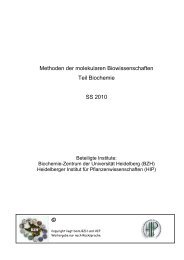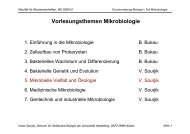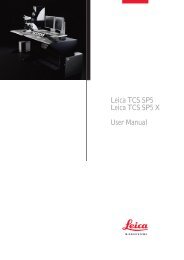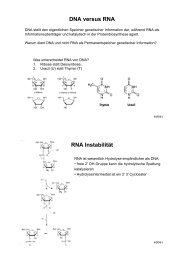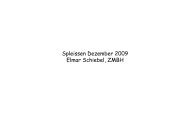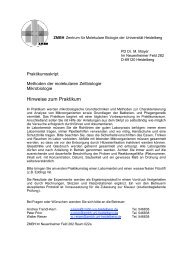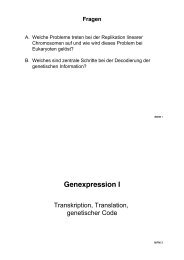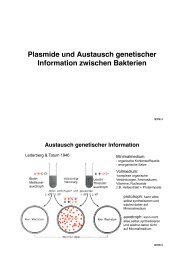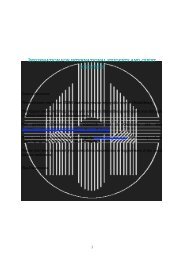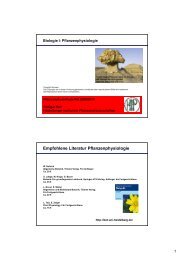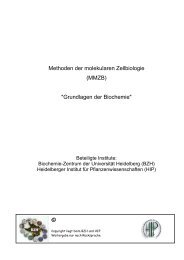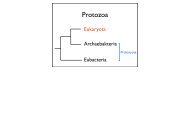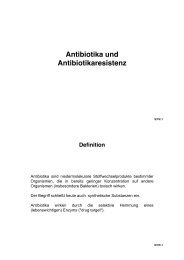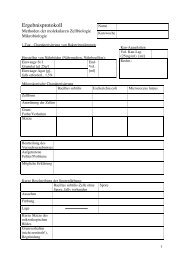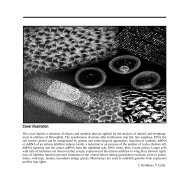ZMBH J.Bericht 2000 - Zentrum für Molekulare Biologie der ...
ZMBH J.Bericht 2000 - Zentrum für Molekulare Biologie der ...
ZMBH J.Bericht 2000 - Zentrum für Molekulare Biologie der ...
You also want an ePaper? Increase the reach of your titles
YUMPU automatically turns print PDFs into web optimized ePapers that Google loves.
Protein Kinase C (PKC) phosphorylates essential<br />
translocon components<br />
O. Gruss with P. Feick, Homburg and R. Frank,<br />
<strong>ZMBH</strong> and S. Owen<br />
Secretion of proteins can occur in a constitutive or<br />
regulated manner. In the exocrine pancreas Ca ++ activated<br />
PKCs play a central role in the regulated secretion.<br />
In or<strong>der</strong> to identify possible targets for PKC<br />
at the ER membrane we have characterized PKCphosphorylated<br />
proteins of rough microsomes and the<br />
rough ER of intact cells. We found that essential components<br />
of the translocation machinery become phosphorylated<br />
in a Ca ++ -dependent manner. Among the<br />
proteins were the α subunit of the SRP receptor, the<br />
β subunit of the Sec61p complex and the TRAM protein.<br />
Isoform -specific antibodies revealed the presence<br />
of PKC α and β on rough ER membranes. Purified<br />
PKCs from rat brain phosphorylated the same<br />
translocon components as the endogenous Ca ++ -<br />
dependent kinases. Phosphorylation of translocon proteins<br />
was also observed in vivo and could be stimulated<br />
by phorbol esters. Phosphorylation of microsomal<br />
proteins by PKCs increased protein translocation<br />
efficiency in vitro. This suggests phosphorylation<br />
as a further level of regulation of protein translocation<br />
across the ER membrane (Gruss et al., 1999).<br />
Protein complexes of the translocation site<br />
L. Wang<br />
Several proteins or protein complexes function at<br />
different stages of the targeting or translocation process.<br />
Among them are the targeting components (SRP<br />
and SRP-receptor) the translocon (Sec61p complex),<br />
translocon associated components (TRAMp, RAMP4)<br />
oligosaccharyl transferase (OST) and signal peptidase<br />
complex. Depending on their functional state they<br />
62<br />
assemble transiently into supercomplexes. This is particularly<br />
evident for the translocon which can be unengaged,<br />
involved in cotranslational or posttranslational<br />
translocation or function in retrotranslocation. To analyse<br />
protein complexes of the rough ER we used mild<br />
solubilisation of ER membrane proteins, fractionation<br />
and blue native PAGE. Consistent with their multiple<br />
engagements we find targeting and translocation components<br />
in distinct oligomeric complexes (Wang and<br />
Dobberstein, 1999).<br />
Translocation-pausing mediated by RAMP4<br />
K. Schrö<strong>der</strong>, B. Martoglio, M. Hofmann in collaboration<br />
with E. Hartman, Göttingen, S. Prehn, Berlin and<br />
T. Rapoport, Boston<br />
Passage of nascent polypeptides across the membrane<br />
of the ER proceeds through a proteinaceous, aqueous<br />
channel formed by the Sec61p complex. To identify<br />
components that may regulate translocation by interacting<br />
with nascent polypeptides in the translocon,<br />
we used site-specific photo-crosslinking. Crosslinkers<br />
were placed around a consensus site for Asn-linked<br />
glycosylation. As a model protein we used the MHC<br />
class II-associated Invariant chain, which contains two<br />
closely spaced N-glycosylation sites. We found that a<br />
region C-terminal of the two consensus glycosylation<br />
sites in the Invariant chain binds in a hydrophobic<br />
interaction to RAMP4, a previously identified Ribosome<br />
Associated Membrane Protein (Görlich and<br />
Rapoport (1993) Cell, 75, 615-630). RAMP4 is a<br />
small, tail anchored protein of 66 amino acid residues.<br />
The interaction of RAMP4 with Ii occurred when<br />
nascent Ii chains reached a length of 170 amino<br />
acid residues and persisted until Ii chain completion,<br />
suggesting translocational pausing (Nakahara et al.<br />
(1994) J. Biol. Chem., 269, 7617-7622). Site-directed<br />
mutagenesis revealed that the region of Ii interacting<br />
with RAMP4 contains essential hydrophobic amino<br />
acid residues. Exchange of these residues for serines<br />
led to a reduced interaction with RAMP4 and inefficient<br />
N-glycosylation. We propose that RAMP4 controls<br />
modification of Ii and possibly also of other<br />
secretory and membrane proteins containing specific<br />
RAMP4-interacting sequences. Efficient or variable<br />
glycosylation of Ii may contribute to its capacity to<br />
modulate antigen presentation by MHC class II molecules<br />
(Schrö<strong>der</strong> et al., 1999).<br />
Figure 1: Hypothetical model of control of Ii chain glycosylation<br />
by RAMP4. Three stages of Ii insertion into the membrane<br />
are depicted. (I) Nascent Ii inserts into the translocon<br />
in a loop-like fashion. (II) When ~170 amino acid residues<br />
have been polymerized Ii interacts via its RIS (white box) with<br />
RAMP4. (III) Translocation is arrested and OST brought into<br />
position to efficiently glycosylate Ii. Upon chain completion, Ii<br />
detaches from RAMP4. Oligosaccharides are shown as forked<br />
structures.<br />
Signal sequences - more than just greasy peptides<br />
B. Martoglio, <strong>ZMBH</strong> / Zürich and M. Fröschke<br />
Signal sequences that target newly synthesized proteins<br />
to the ER contain a hydrophobic core region but<br />
otherwise show a great variation in both, overall length<br />
and amino acid sequence. Recently, it has become<br />
clear that this variation allows signal sequences to<br />
specify different modes of targeting and membrane<br />
insertion and even to perform functions after being<br />
cleaved from their parent protein. Signal sequences<br />
are therefore not simply greasy peptides but sophisticated,<br />
multipurpose peptides containing a wealth of<br />
functional information (Martoglio and Dobberstein,<br />
1998). Further work is directed to the functional analysis<br />
of unusually long signal sequences during targeting,<br />
proteolytic processing and after signal sequence<br />
cleavage.<br />
Signal sequences of the prion protein (PrP)<br />
C. Hölscher and U. C. Bach<br />
Prion protein (PrP) is synthesised at the membrane of<br />
the ER in three different topological forms, a secreted<br />
one (secPrP) and two that span the membrane in opposite<br />
orientations ( Ntm PrP and Ctm PrP). To identify signal<br />
sequences in PrP that determine the generation of the<br />
multiple forms of PrP we performed a deletion analysis.<br />
We found that PrP has – besides its N-terminal<br />
signal sequence- a C-terminal signal sequence that<br />
functions posttranslationally. The C-terminal signal<br />
sequence mainly mediates synthesis of Ctm PrP. Ctm PrP<br />
has been causally connected to certain inherited forms<br />
of neurodegeneration (Hegde et al. Nature, 402, 822 –<br />
826, 1999). We suggest that multiple forms of PrP are<br />
generated by the differential use of a N-terminal and<br />
C-terminal signal sequence (Hölscher, Bach and Dobberstein,<br />
in preparation).<br />
mRNA transport and protein localisation<br />
S. Frey and M. Seedorf in collaboration with R.<br />
Jansen, <strong>ZMBH</strong><br />
mRNA always exits the nucleus in a complex with<br />
RNA-binding proteins. Prior to translation complexes<br />
63



